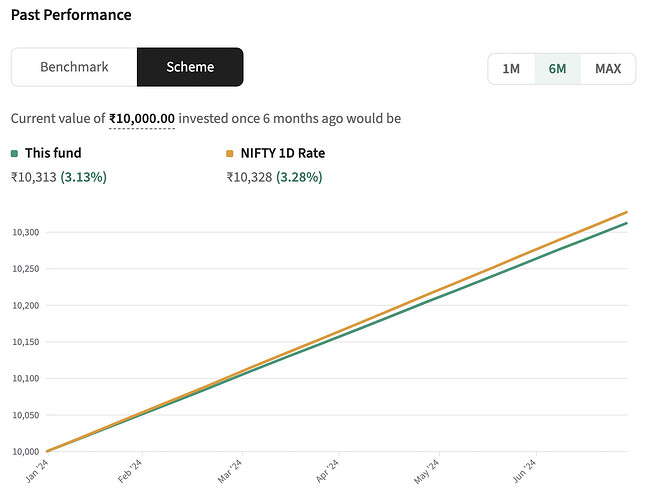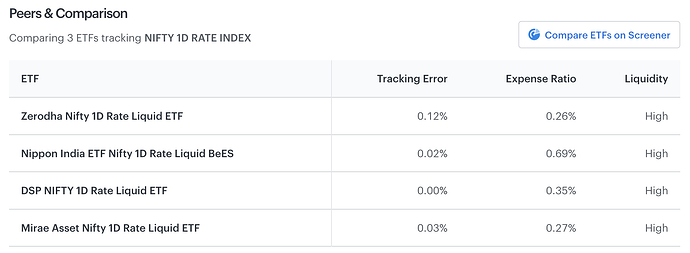@Meher_Smaran @ShubhS9 Please provide an update on this, I’ve seen a long list of people requesting this along with an even longer list of timelines. Hoping the team releases this soon.
Hi,
When I do sell the LIQUIDCASE at some point in future, does it make sense to sell it all at once or sell in parts from gains perspective? (I would assume I have to pay brokerage and other market charges if I sell in parts and that many times the charges).
Also an unrelated question towards ZERODHA console:
-
Does the console factor in the brokerage and other market charges and also the 9rupee plus GST as well during XIRR calculation?
-
if my holding are short period of time and returns are in negative, my XIRR is showing 0 so far. Is that correct ?
Thanks very much.
Xirr is for investments longer than 1 year. It can be negative too.
Thank you.
Hi all,
Came across this article, it seems that for overnight mutual funds the haircut will be revised to just 5%. This sounds great and it seems these funds will be the best choice going forward for the cash collateral.
Does anyone know when this will start? And if LIQUIDCASE will be eligible for the lower haircut?
Just skimmed it, but maybe it takes effect from aug 1. See page 13
Hi All,
Lets say i want to switch from LIQUIDCASE to another ETF in near future, is there a way i can do it without the money hitting my bank account?
Thanks
You need to sell those units and buy another ETF which you are planning to buy. If you bought the LIQUIDCASE through kite (NSE or BSE), then the money will get settled in Kite account and you can buy another ETF them from kite account.
Do you guys have any plans to bring forth any version of this which would invest in longer run GSECs?
Short term gsecs, say around 1-2 years, would be perfect for pledging too.
Hopefully better yield vs liquid case, slight duration risk and no credit risk.
We only seem to have 10y or dynamic gilt funds now.
@VishalJain I would like to know your views on:
-
Since Liquidcase tracks Nifty 1D rate as its benchmark, is there any impact of the scheduled calendar rebalancing of the indices? https://www.niftyindices.com/resources/index-rebalancing-schedule
-
For the past 6 months, Liquidcase has been lagging behind its benchmark Nifty 1D rate. Liquidcase (3.13%) vs Nifty 1D (3.28%).
- The expense ratio of Liquidcase remains 0.26% despite the AUM growing significantly since the NFO launch. Rs 1698.38 crore as mentioned on the website. Zerodha Nifty 1D Rate Liquid ETF | LIQUIDCASE Mutual Fund
Though the expense ratio of Liquidcase (0.26%, growth based) is lower than the Nippon Liquidbees ETF (0.69%, i can understand higher because of its dividend-paying nature), if you notice, the category expense ratio is 0.19%. So there indeed is room to make the expense ratio of Liquidcase even lower. Especially, combined with point #2 growing AUM.
- If you compare the tracking error of Liquidcase to the peer Liquid ETFs, you’d notice that Zerodha Liquidcase tracking error is 0.12% which is higher than the peers. So again, Liquidcase investors deserve lower tracking error. This will improve performance of Liquidcase when compared to its benchmark i.e. point #1. Zerodha Nifty 1D Rate Liquid ETF: Peer comparison and competitor analysis
I am willing to park some unused funds. So doing my homework and raising such questions after deeply looking into Liquidcase. More so because I was among those who requested this product long back and have been keenly watching it since its launch.
Over to you now ![]()
@VishalJain
Sorry a newbie so help me understand this fund.
Returns: Are we saying that this fund reinvests interest on principal calculated as Principal*(((ROI-ExpenseRatio)/365)/100) Eg: 100000*(((3.26-0.26)/365)/100) = ~8Rs daily?
Reasons: Why would people like to park their equity buying capital here, How is this beneficial then keeping your money in bank account?
Pros & Cons
Bankaccount:
- It would highlight as High Value Transaction if you are transferring money >10L to buy your fav equity.
- You would incur 9rs+GST for the NEFT account balance transfer.
- You would get 4% per quater in bank. with a exemption of 10K under 80TTA
VS LIQUIDCASE
- You withdraw you are taxed on your slab.
- There is brokerage(or other cost) for buying and selling this? (not sure, confused with comments above)
- Money never hits you bank account (not sure if that is a pro)
- This has an expense ratio effectively reducing your earnings.
- Pledge opportunity for Intra day and option traders.
I feel cons outweigh pro’s am i missing anything here?
With Liquidcase, you can pledge the shares and use upto 90% as cash collateral, while still earning interest on it.
Ok Pledge is good for daily trader, not investor but i get the point +1 for liquidcase
market makers are greedy ![]()
whenever there is a steep premium (usually in EQ instruments) or anomaly in return (lesser return in debt), blame it on them
Yes, I’m a trader… But I fail to see why an investor cannot use it. Can you please help me understand?
@NewUser123 leverage by pledging can only be used for either Intraday equity trades or FnO only…
Investors buy CNC for which pledges or leverages are not usefull…
Thanks for the clarification. Was under the impression that the 90% cash component could be used to buy equity too.
Thanks.
Hey Rupesh, thanks for writing in. My response is as follows:-
-
NIFTY 1D Rate is a single security benchmark and there are no periodic rebalancing
-
Structurally Liquidcase is expected to lag on account of following factors;
a. Nifty 1D rate index does not have any cash while due to operational reasons the fund normally has to keep some cash
b. TER of the scheme -
Our decision on expense ratios depends on many factors such as the market/client segment we operate in, business dynamics, sustainability, operational costs, etc. Despite being a new product, you will agree we have priced the product competitively to ensure investors benefit from an innovative product like LIQUIDCASE and with the objective that it will reach certain economies of scale.
-
Tracking Error is a statistical number and therefore larger the number of data points, lower would be the standard deviation. LIQUIDCASE is a new fund and hence has lower number of data points as compared to the other schemes in existence. You will notice that the tracking error has been constantly reducing as the scheme is getting older. Keeping in mind that this is a daily reset debt product having a single underlying, I would suggest to add another metric to your analysis which is the “Tracking Difference”, which is the simple difference between the scheme returns and the index.
Hope this helps!

